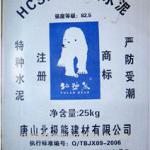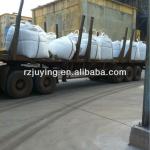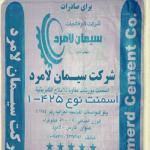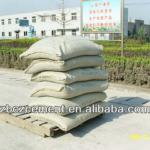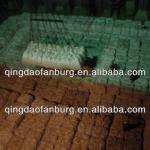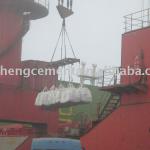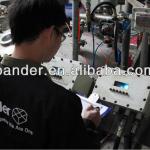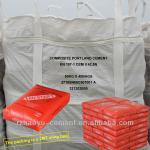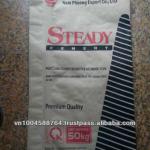Cement powder we have the largest factory in China west find good partner - new-leaderCement
| Place of Origin: Shaanxi China (Mainland) | Brand Name: Newleader | Model Number: new-leaderCement | Color: Grey |
| Feature: Acid-Proof,Anti-Algae,Decorative,Expansive,Refractory,Sulfate Resistant | Main Raw Material: Aluminate | Type: Portland Fly-Ash Cement | Hardening Feature: Extra Rapid Hardening |
| Heat of Hydration: Low-Heat | Strength Grade(Mpa): 32.5 | Cement powder: Cement powder |
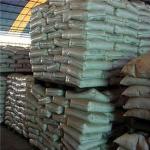
Cement powder
In the most general sense of the word, acementis a binder, a substance that sets and hardens independently, and can bind other materials together. The word "cement" traces to the Romans, who used the termopus caementiciumto describe masonry resembling modern concrete that was made from crushed rock with burnt lime as binder. The volcanic ash and pulverized brick additives that were added to the burnt lime to obtain a hydraulic binder were later referred to ascementum,cimentum,cäment, andcement.
Cements used in construction can be characterized as being eitherhydraulicornon-hydraulic. Hydraulic cements (e.g.,Portland cement) harden because of hydration, a chemical reaction between the anhydrous cement powder and water. Thus, they can harden underwater or when constantly exposed to wet weather. The chemical reaction results in hydrates that are not very water-soluble and so are quite durable in water. Non-hydraulic cements do not harden underwater; for example, slaked limes harden by reaction with atmospheric carbon dioxide.[1]
The most important uses of cement are as an ingredient in the production of mortar in masonry, and of concrete, a combination of cement and an aggregate to form a strong building material.
History of the origin of cement[edit]
Early uses[edit]
An early version of cement made with lime, sand, and gravel was used in Mesopotamia in the third millennium B.C. and later in Egypt. It is uncertain where it was first discovered that a combination of hydrated non-hydraulic lime and a pozzolan produces a hydraulic mixture (see also: Pozzolanic reaction), but concrete made from such mixtures was first used by the Ancient Macedonians[2][3]and three centuries later on a large scale by Roman engineers.[4]They used both natural pozzolans (trass or pumice) and artificial pozzolans (ground brick or pottery) in these concretes. Many excellent examples of structures made from these concretes are still standing, notably the huge dome of the Pantheon in Rome and the massive Baths of Caracalla.[5]The vast system of Roman aqueducts also made extensive use of hydraulic cement.[6]
Although any preservation of this knowledge in literary sources from the Middle Ages is unknown, medieval masons and some military engineers maintained an active tradition of using hydraulic cement in structures such as canals, fortresses, harbors, and shipbuilding facilities.[7][8]The technical knowledge of making hydraulic cement was later formalized by French and British engineers in the 18th century.[7]
Modern cements[edit]
Modern hydraulic cements began to be developed from the start of the Industrial Revolution (around 1800), driven by three main needs:
- Hydraulic cement render (stucco) for finishing brick buildings in wet climates.
- Hydraulic mortars for masonry construction of harbor works, etc., in contact with sea water.
- Development of strong concretes.
In Britain particularly, good quality building stone became ever more expensive during a period of rapid growth, and it became a common practice to construct prestige buildings from the new industrial bricks, and to finish them with a stucco to imitate stone. Hydraulic limes were favored for this, but the need for a fast set time encouraged the development of new cements. Most famous was Parker's "Roman cement".[9]This was developed by James Parker in the 1780s, and finally patented in 1796. It was, in fact, nothing like any material used by the Romans, but was a "Natural cement" made by burning septaria – nodules that are found in certain clay deposits, and that contain both clay minerals and calcium carbonate. The burnt nodules were ground to a fine powder. This product, made into a mortar with sand, set in 5–15 minutes. The success of "Roman Cement" led other manufacturers to develop rival products by burning artificial mixtures of clay and chalk.
John Smeaton made an important contribution to the development of cements when he was planning the construction of the third Eddystone Lighthouse (1755–9) in the English Channel. He needed a hydraulic mortar that would set and develop some strength in the twelve hour period between successive high tides. He performed an exhaustive market research on the available hydraulic limes, visiting their production sites, and noted that the "hydraulicity" of the lime was directly related to the clay content of the limestone from which it was made. Smeaton was a civil engineer by profession, and took the idea no further. Apparently unaware of Smeaton's work, the same principle was identified by Louis Vicat in the first decade of the nineteenth century. Vicat went on to devise a method of combining chalk and clay into an intimate mixture, and, burning this, produced an "artificial cement" in 1817.[10]James Frost,[11]working in Britain, produced what he called "British cement" in a similar manner around the same time, but did not obtain a patent until 1822. In 1824, Joseph Aspdin patented a similar material, which he called Portland cement, because the render made from it was in color similar to the prestigious Portland stone.
Setting time and "early strength" are important characteristics of cements. Hydraulic limes, "natural" cements, and "artificial" cements all rely upon their belite content for strength development. Belite develops strength slowly. Because they were burned at temperatures below 1250 °C, they contained no alite, which is responsible for early strength in modern cements. The first cement to consistently contain alite was made by Joseph Aspdin's son William in the early 1840s. This was what we call today "modern" Portland cement. Because of the air of mystery with which William Aspdin surrounded his product, others (e.g.,Vicat and I.C. Johnson) have claimed precedence in this invention, but recent analysis[12]of both his concrete and raw cement have shown that William Aspdin's product made at Northfleet, Kent was a true alite-based cement. However, Aspdin's methods were "rule-of-thumb": Vicat is responsible for establishing the chemical basis of these cements, and Johnson established the importance of sintering the mix in the kiln.
William Aspdin's innovation was counterintuitive for manufacturers of "artificial cements", because they required more lime in the mix (a problem for his father), a much higher kiln temperature (and therefore more fuel), and the resulting clinker was very hard and rapidly wore down the millstones, which were the only available grinding technology of the time. Manufacturing costs were therefore considerably higher, but the product set reasonably slowly and developed strength quickly, thus opening up a market for use in concrete. The use of concrete in construction grew rapidly from 1850 onward, and was soon the dominant use for cements. Thus Portland cement began its predominant role.
In the US the first large scale use of cement was Rosendale cement a natural cement mined from a massive deposit of a large dolostone rock deposit discovered in the early 19th century near Rosendale, New York. Rosendale cement was extremely popular for the foundation of buildings (e.g., Statue of Liberty, Capitol Building, Brooklyn Bridge) and lining water pipes. But its long curing time of at least a month made it unpopular after World War One in the construction of highways and bridges and many states and construction firms turned to the use of Portland cement. Because of the switch to Portland cement, by the end of the 1920s of the 15 Rosendale cement companies, only one had survived. But in the early 1930s it was soon discovered that, while Portland cement had a faster setting time it was not as durable, especially for highways, to the point that some states stopped building highways and roads with cement. Bertrain H. Wait, an engineer whose company had worked on the construction of the New York Cities Catskill Aqueduct, was impressed with the durability of Rosendale cement, and came up with a blend of both Rosendale and synthetic cements which had the good attributes of both: it was highly durable and had a much faster setting time. Mr. Wait convinced the New York Commissioner of Highways to construct an experimental section of highway near New Paltz, New York, using one sack of Rosendale to six sacks of synthetic cement, and it was proved a success and for decades the Rosendale-synthetic cement blend became common use in highway and bridge construction.[13]
Types of modern cement[edit]
Portland cement[edit]
Cement is made by heating limestone (calcium carbonate) with small quantities of other materials (such as clay) to 1450 °C in a kiln, in a process known as calcination, whereby a molecule of carbon dioxide is liberated from the calcium carbonate to form calcium oxide, or quicklime, which is then blended with the other materials that have been included in the mix. The resulting hard substance, called 'clinker', is then ground with a small amount of gypsum into a powder to make 'Ordinary Portland Cement', the most commonly used type of cement (often referred to as OPC). Portland cement is a basic ingredient of concrete, mortar and most non-specialty grout. The most common use for Portland cement is in the production of concrete. Concrete is a composite material consisting of aggregate (gravel and sand), cement, and water. As a construction material, concrete can be cast in almost any shape desired, and once hardened, can become a structural (load bearing) element. Portland cement may be grey or white.
Energetically modified cement[edit]
The grinding process to produce Energetically modified cement (EMC) yields materials made from pozzolanic minerals that have been treated using a patented milling process ("EMC Activation").[14]This yields a high-level replacement of Portland cement in concrete with lower costs, performance and durability improvements, with significant energy and carbon dioxide savings.[15]The resultant concretes can have the same, if not improved, physical characteristics as "normal" concretes, at a fraction of the cost of using Portland cement.[16]
Portland cement blends[edit]
Portland cement blends are often available as inter-ground mixtures from cement producers, but similar formulations are often also mixed from the ground components at the concrete mixing plant.[17]Portland blastfurnace cementcontains up to 70% ground granulated blast furnace slag, with the rest Portland clinker and a little gypsum. All compositions produce high ultimate strength, but as slag content is increased, early strength is reduced, while sulfate resistance increases and heat evolution diminishes. Used as an economic alternative to Portland sulfate-resisting and low-heat cements.[18]Portland flyash cementcontains up to 35% fly ash. The fly ash is pozzolanic, so that ultimate strength is maintained. Because fly ash addition allows a lower concrete water content, early strength can also be maintained. Where good quality cheap fly ash is available, this can be an economic alternative to ordinary Portland cement.[19]Portland pozzolan cementincludes fly ash cement, since fly ash is a pozzolan, but also includes cements made from other natural or artificial pozzolans. In countries where volcanic ashes are available (e.g. Italy, Chile, Mexico, the Philippines) these cements are often the most common form in use.Portland silica fume cement. Addition of silica fume can yield exceptionally high strengths, and cements containing 5–20% silica fume are occasionally produced. However, silica fume is more usually added to Portland cement at the concrete mixer.[20]Masonry cementsare used for preparing bricklaying mortars and stuccos, and must not be used in concrete. They are usually complex proprietary formulations containing Portland clinker and a number of other ingredients that may include limestone, hydrated lime, air entrainers, retarders, waterproofers and coloring agents. They are formulated to yield workable mortars that allow rapid and consistent masonry work. Subtle variations of Masonry cement in the US are Plastic Cements and Stucco Cements. These are designed to produce controlled bond with masonry blocks.Expansive cementscontain, in addition to Portland clinker, expansive clinkers (usually sulfoaluminate clinkers), and are designed to offset the effects of drying shrinkage that is normally encountered with hydraulic cements. This allows large floor slabs (up to 60 m square) to be prepared without contraction joints.White blended cementsmay be made using white clinker and white supplementary materials such as high-purity metakaolin.Colored cementsare used for decorative purposes. In some standards, the addition of pigments to produce "colored Portland cement" is allowed. In other standards (e.g. ASTM), pigments are not allowed constituents of Portland cement, and colored cements are sold as "blended hydraulic cements".Very finely ground cementsare made from mixtures of cement with sand or with slag or other pozzolan type minerals that are extremely finely ground together. Such cements can have the same physical characteristics as normal cement but with 50% less cement particularly due to their increased surface area for the chemical reaction. Even with intensive grinding they can use up to 50% less energy to fabricate than ordinary Portland cements.[21]
Non-Portland hydraulic cements[edit]
Pozzolan-lime cements.Mixtures of ground pozzolan and lime are the cements used by the Romans, and can be found in Roman structures still standing (e.g. the Pantheon in Rome). They develop strength slowly, but their ultimate strength can be very high. The hydration products that produce strength are essentially the same as those produced by Portland cement.Slag-lime cements.Ground granulated blast furnace slag is not hydraulic on its own, but is "activated" by addition of alkalis, most economically using lime. They are similar to pozzolan lime cements in their properties. Only granulated slag (i.e. water-quenched, glassy slag) is effective as a cement component.Supersulfated cements.These contain about 80% ground granulated blast furnace slag, 15% gypsum or anhydrite and a little Portland clinker or lime as an activator. They produce strength by formation of ettringite, with strength growth similar to a slow Portland cement. They exhibit good resistance to aggressive agents, including sulfate.Calcium aluminate cementsare hydraulic cements made primarily from limestone and bauxite. The active ingredients are monocalcium aluminate CaAl2O4(CaO · Al2O3or CA in Cement chemist notation, CCN) and mayenite Ca12Al14O33(12 CaO · 7 Al2O3, or C12A7in CCN). Strength forms by hydration to calcium aluminate hydrates. They are well-adapted for use in refractory (high-temperature resistant) concretes, e.g. for furnace linings.Calcium sulfoaluminate cementsare made from clinkers that include ye'elimite (Ca4(AlO2)6SO4or C4A3Sin Cement chemist's notation) as a primary phase. They are used in expansive cements, in ultra-high early strength cements, and in "low-energy" cements. Hydration produces ettringite, and specialized physical properties (such as expansion or rapid reaction) are obtained by adjustment of the availability of calcium and sulfate ions. Their use as a low-energy alternative to Portland cement has been pioneered in China, where several million tonnes per year are produced.[22][23]Energy requirements are lower because of the lower kiln temperatures required for reaction, and the lower amount of limestone (which must be endothermically decarbonated) in the mix. In addition, the lower limestone content and lower fuel consumption leads to a CO2emission around half that associated with Portland clinker. However, SO2emissions are usually significantly higher."Natural" cementscorrespond to certain cements of the pre-Portland era, produced by burning argillaceous limestones at moderate temperatures. The level of clay components in the limestone (around 30–35%) is such that large amounts of belite (the low-early strength, high-late strength mineral in Portland cement) are formed without the formation of excessive amounts of free lime. As with any natural material, such cements have highly variable properties.Geopolymer cementsare made from mixtures of water-soluble alkali metal silicates and aluminosilicate mineral powders such as fly ash and metakaolin.
Curing (Setting)
Cement sets or cures when mixed with water which causes a series of hydration chemical reactions. The constituents slowly hydrate and crystallize; the interlocking of the crystals gives cement its strength. Maintaining a high moisture content in cement during curing increases both the speed of curing, and its final strength. Gypsum is often added to Portland cement to prevent early hardening or "flash setting", allowing a longer working time. The time it takes for cement to cure varies depending on the mixture and environmental conditions; initial hardening can occur in as little as twenty minutes, while full cure can take over a month. Cement typically cures to the extent that it can be put into service within 24 hours to a week.
Safety issues
Bags of cement routinely have health and safety warnings printed on them because not only is cement highly alkaline, but the setting process is exothermic. As a result, wet cement is strongly caustic and can easily cause severe skin burns if not promptly washed off with water. Similarly, dry cement powder in contact with mucous membranes can cause severe eye or respiratory irritation. Cement users should wear protective clothing.[24][25][26]
Cement industry in the world
In 2010, the world production of hydraulic cement was 3,300 million tonnes. The top three producers were China with 1,800, India with 220, and USA with 63.5 million tonnes for a combined total of over half the world total by the world's three most populated states.[27]
For the world capacity to produce cement in 2010, the situation was similar with the top three states (China, India, and USA) accounting for just under half the world total capacity.[28]
| Packaging Detail:25kg/bag |
| Delivery Detail:30-45days |



